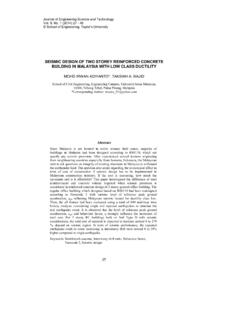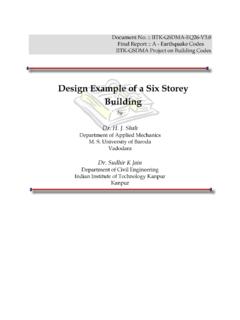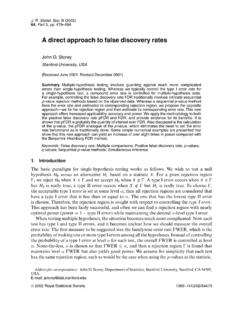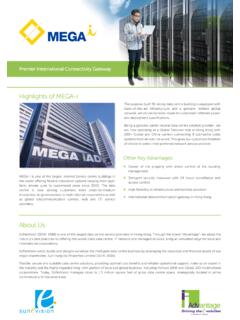Transcription of 14. Design of plumbing systems for multi-storey …
1 HEALTH ASPECTS OF PLUMBING707114. Design of plumbing systems for multi-storey buildings14. Design OF plumbing systems FOR multi-storey BUILDINGSFor plumbing purposes, the term multi-storey is applied to buildings that are too tall to be supplied throughout by the normal pressure in the public water mains. These buildings have particular needs in the Design of their sanitary drainage and venting systems . Water main supply pressures of 8 12 metres (25 40 feet) can supply a typical two-storey building, but higher buildings may need pressure booster systems .
2 In hilly areas, the drinking-water supply pressures will vary depending on the ground elevation. In these cases, the water authority may have to specify areas where particular supply pressures can be relied upon for the Design and operation of buildings. Where a building of three or more storeys is proposed a certificate should be obtained from the drinking-water supply authority guaranteeing that the present and future public drinking-water supply pressure will be adequate to serve the building. If the public water pressure is inadequate, suitable means shall be provided within the building to boost the water systems for boosting water pressurePressure-boosting systems can be of several different types: pumping from a ground level or basement gravity tank to a gravity roof tank; pumping from a gravity storage tank or public water main into a hydro-pneumatic pressure tank that uses captive air pressure to provide adequate drinking-water supply pressure.
3 Installation of booster pump sets consisting of multiple staged pumps or variable speed pumps that draw water directly from a gravity storage tank or the public water main. Multistage booster pump sets typically include discharge pressure regulating valves to maintain a constant drinking-water supply approval should be obtained from the appropriate authority before any pump or booster is connected to the supply. Where booster pump sets are permitted to draw directly from public water mains, the public drinking-water supply must be adequate to meet the peak demands of all buildings in the area.
4 Otherwise, there is a high risk of backflow and subsequent contamination of the mains from buildings not equipped with a booster pump. Building booster HEALTH ASPECTS OF PLUMBING7273pumps are not a solution to the problem of inadequate drinking-water supply. Where public drinking-water supply systems are overburdened and cannot pro-vide adequate pressure on a continuous basis, water must be stored on site during periods when adequate pressure is available to fill a gravity storage tank. The size of the storage tank will vary according to the daily water demand of the build-ing, and the availability of adequate pressure available in the public water mains.
5 It should not be excessively oversized to avoid stagnation due to inadequate buildings can usually be divided into zones of water pressure control. The lower two to three storeys can generally be supplied directly from the pressure in the public water main. Upper storeys, usually in groups of five to eight storeys, can be supplied from pressure-boosted main risers through a pressure reduction valve for each group. systems can be up-fed or down-fed. Up-fed systems usually originate from a pressure booster pump set or hydro-pneumatic tank in the basement of the building.
6 Down-fed systems usually originate from a rooftop gravity tank. Where a building is divided into water pressure zones, care must be taken not to cross-connect the piping between two or more zones. This is a particular problem when domestic hot water is recircu-lated from a central supply hydropneumatic tanks are used for storage, the tank is filled to one third to a half full by a float level device that controls the drinking-water supply source (a well pump or pressure booster pump). The pressure is maintained at the desired operating level by an air compressor.
7 As the building uses water from the tank, the water level and air pressure drop. When the water level drops to the on setting of the float level control, the well pump or booster pump starts and raises the water level in the tank to the off level. This restores the pressure in the tank. If some of the captive air above the water has been absorbed by the water, the air compressor starts and restores the air charge, raising the system pressure to the normal level. Hydropneumatic tanks are typically made of steel or fibreglass and must be rated for the system operating pressure.
8 Steel tanks must have a protective coating of suitable composition for drinking-water contact on the inside to protect the tank from corrosion and avoid contaminating the water. They should be checked on a regular basis to ensure that the protective coating is intact and the water remains hydropneumatic tanks can also be used to help control pressure booster pumps, allowing them to be cycled on and off by a pressure switch. The captive air within the tank keeps the system pressurized while the pump is off. When the water pressure drops to the on pressure setting, the pump starts and raises the volume and pressure of the water in the tank.
9 No air compressor is needed where tanks have a flexible diaphragm between the air and the water in the tank, charged with air at initial start-up. The size of pressure tanks for booster pumps must match the capacity of the pump and the peak system HEALTH ASPECTS OF PLUMBING7273demand so that the pump off cycle is longer than the on cycle and the pump does not cycle too Drainage Drainage system considerationsIn the drainage system for a multi-storey building, the drains from the plumbing fixtures are connected to vertical drain stacks that convey the waste and sewage to below the lowest floor of the building.
10 The fixture drain traps must be vented to prevent their water trap seal from being siphoned by negative pressure or blown out by positive pressure in the drain piping. The fixture vent pipes must extend through the roof to outdoors. They can be run individually or be combined into one or more vents through the roof. Where buildings are over 10 storeys high, the drainage stacks require relief vent connections at specified intervals from the top, and connected to a vent stack that terminates above the roof. This relieves and equalizes the pressure in the drainage stack to maintain the water seal in traps serving plumbing possible, the sanitary drainage system from a building should discharge to the public sewer by gravity.















